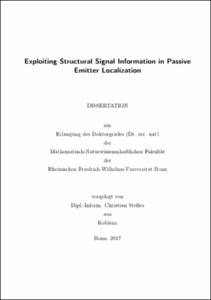Exploiting Structural Signal Information in Passive Emitter Localization

Exploiting Structural Signal Information in Passive Emitter Localization

| dc.contributor.advisor | Koch, Wolfgang | |
| dc.contributor.author | Steffes, Christian | |
| dc.date.accessioned | 2020-04-24T08:01:43Z | |
| dc.date.available | 2020-04-24T08:01:43Z | |
| dc.date.issued | 22.08.2017 | |
| dc.identifier.uri | https://hdl.handle.net/20.500.11811/7239 | |
| dc.description.abstract | The operational use of systems for passive geolocation of radio frequency emitters poses various challenges to single sensor systems or sensor networks depending on the measurement methods. Position estimation by means of direction finding systems often requires complex receiver and antenna technique. Time (Difference) of Arrival methods (TDOA, TOA) are based on measurements regarding the signal propagation duration and generally require broadband communication links to transmit raw signal data between spatially separated receivers of a sensor network. Such bandwidth requirements are particularly challenging for applications with moving sensor nodes. This issue is addressed in this thesis and techniques that use signal structure information of the considered signals are presented which allow a drastic reduction of the communication requirements. The advantages of using knowledge of the signal structure for TDOA based emitter localization are shown using two exemplary applications. The first case example deals with the passive surveillance of the civil airspace (Air Traffic Management, ATM) using a stationary sensor network. State of the art airspace surveillance is mainly based on active radar systems (Primary Surveillance Radar, PSR), cooperative secondary radar systems (Secondary Surveillance Radar, SSR) and automatic position reports from the aircraft itself (Automatic Dependent Surveillance-Broadcast, ADS-B). SSR as well as ADS-B relies on aircrafts sending transponder signals at a center frequency of 1090 MHz. The reliability and accuracy of the position reports sent by aircrafts using ADS-B are limited and not sufficient to ensure safe airspace separation for example of two aircrafts landing on parallel runways. In the worst case, the data may even be altered with malicious intent. Using passive emitter localization and tracking based on multilateration (TDOA/hyperbolic localization), a precise situational awareness can be given which is independent of the content of the emitted transponder signals. The high concentration of sending targets and the high number of signals require special signal processing and information fusion techniques to overcome the huge amount of data. It will be shown that a multilateration network that employs those techniques can be used to improve airspace security at reasonable costs. For the second case, a concept is introduced which allows TDOA based emitter localization with only one moving observer platform. Conventional TDOA measurements are obtained using spatially distributed sensor nodes which capture an emitted signal at the same time. From those signals, the time difference of arrival is estimated. Under certain conditions, the exploitation of signal structure information allows to transfer the otherwise only spatial into a spatial and temporal measurement problem. This way, it is possible to obtain TDOA estimates over multiple measurement time steps using a single moving observer and to thus localize the emitter of the signals. The concept of direct position determination is applied to the single sensor signal structure TDOA scheme and techniques for direct single sensor TDOA are introduced. The validity and performance of the presented methods is shown in theoretical analysis in terms of Cramér-Rao Lower Bounds, Monte-Carlo simulations and by evaluation of real data gained during field experiments. | en |
| dc.language.iso | eng | |
| dc.rights | In Copyright | |
| dc.rights.uri | http://rightsstatements.org/vocab/InC/1.0/ | |
| dc.subject | Emitterlokalisierung | |
| dc.subject | TDOA | |
| dc.subject | TOA | |
| dc.subject | Multilateration | |
| dc.subject | S4TDOA | |
| dc.subject | DS4TDOA | |
| dc.subject | Radar | |
| dc.subject.ddc | 004 Informatik | |
| dc.title | Exploiting Structural Signal Information in Passive Emitter Localization | |
| dc.type | Dissertation oder Habilitation | |
| dc.publisher.name | Universitäts- und Landesbibliothek Bonn | |
| dc.publisher.location | Bonn | |
| dc.rights.accessRights | openAccess | |
| dc.identifier.urn | https://nbn-resolving.org/urn:nbn:de:hbz:5n-48060 | |
| ulbbn.pubtype | Erstveröffentlichung | |
| ulbbnediss.affiliation.name | Rheinische Friedrich-Wilhelms-Universität Bonn | |
| ulbbnediss.affiliation.location | Bonn | |
| ulbbnediss.thesis.level | Dissertation | |
| ulbbnediss.dissID | 4806 | |
| ulbbnediss.date.accepted | 06.07.2017 | |
| ulbbnediss.institute | Mathematisch-Naturwissenschaftliche Fakultät : Fachgruppe Informatik / Institut für Informatik | |
| ulbbnediss.fakultaet | Mathematisch-Naturwissenschaftliche Fakultät | |
| dc.contributor.coReferee | Martini, Peter |
Dateien zu dieser Ressource
Das Dokument erscheint in:
-
E-Dissertationen (4337)




